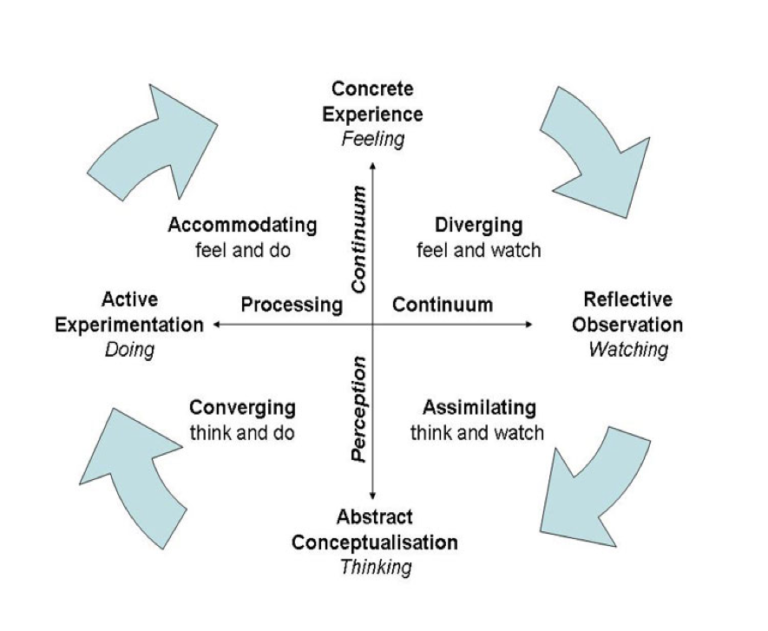
What if knowing about how to accommodate different learning styles in the classroom involved an assessment on yourself as a language teacher, rather than on your students? In this article you are going to learn about the learning styles and the unique, genuinely effective strategy for making the most out of your language students learning styles.
What are the 4 learning styles
Learning styles are our preferences when it comes to learning. Some people like listening to theoretical lectures, some other prefer to get involved in practical activities and to draw their own conclusions, and further on. According to David Kolb’s theory, we all have four learning styles. Those four learning styles are the output of the combination between the way we like getting involved in the learning process and take in information (either by feeling and taking part in concrete experiences or by thinking and reflecting on abstract conceptualizations) and the way we process new information and make sense of it (either by doing and by active experimentation or by watching and by reflective observation). You might be familiar with Kolb’s learning styles model:

As a result, there are four types of learners:
- Type 1 (feel and watch) is the Diverger. Divergers like to take in information through concrete experiences and to make sense of it through their own observations and reflection. They prefer to experience practical activities and to rely on their own intuition to decide if the content is relevant to them. They usually need time for experiencing, elaborating and thinking things through before taking action with what you taught them.
- Type 2 (think and watch) is the Assimilator. Assimilators like to take in information through theoretical conceptualization and to make sense of it through their own observations and reflection. They like lectures and formal setting training. They usually rely on external information, data, case studies or the proved prestige of the teacher to decide if the new information is relevant to them. Because they need to think things through, just like type 1 learners, they need time before taking action with what you taught them.
- Type 3 (think and do) is the Converger. Convergers like to take in information through theoretical conceptualization and to make sense of it through concrete experiences and activities. They absorb the game rules and then they try to put them into use. That’s why they like playing around with the new information, testing it, experimenting and eventually they decide if the new content is relevant to them when they find it enough practical.
- Type 4 (feel and do) is the Accomodator. Accomodators like to take in information through concrete experiences and to make sense of it by “doing”, through concrete activities. They decide on the practical usefulness of what you taught them based on their own intuition. They don’t get on well with theoretical explanations, they prefer taking action and experimenting.
I’m sure you are thinking about your students as you’re reading this post and that you have already some examples in mind for each learner type.
And still, knowing about THEIR learning styles won’t help you in how to accommodate different learning styles in the classroom. Let’s debunk a myth.
Does knowing about your students’ learning styles really matter? A myth debunked
The need to know your students’ learning styles to be more effective as a language teacher is just a myth. In fact, knowing about your students’ dominant learning styles is NOT that relevant for the purpose of teaching. I mean, as teachers we have to get the students engaged through a range of different activities and methods that encourage the students to activate all different styles in order to take them to Acquisition. This applies to teaching groups of students (where by all means there is a melting pot of learning styles). And it’s true even in individual, 1-to-1 lessons. As teachers, on one hand we can’t just stick to one or two types of exercises or methods just because they relate to the dominant learning styles in the classroom. On the contrary, we need to give different instructions and tasks in order to personalise the acquisition process.
It’s a bit like training for strengthening your muscles: if you only train your upper body, then your legs might get weak. In that case, a good personal trainer would suggest you to balance your training plan and to choose exercises for engaging your legs, too.
I give you an example. As a learner, I fall within type 3. I’m alright with traditional training settings. I like taking in information through formal training experiences, but then I need to put my hands on the new information and test it out. When I plan language lessons for my students, I need to pay attention to my preferences because not everybody is OK with theoretical frameworks and formal explanations. That’s why I usually start most of my courses with practical activities or with engaging and fun exercises for getting everybody onboard.
How to accommodate different learning styles in the classroom, then?
The thing is: your preferred learning style affects your teaching style, too. Therefore, the only strategy that genuinely works is based on self-assessment and stretching.
It is important you know your own dominant learning style in order to work out solutions for reaching all students, included those students who have different learning styles to yours. In fact, in the classroom you might get on well with the students who share with you the same preferred learning style, whereas you might struggle to engage the students who have different preferences.
Therefore, you need to become aware of your style and to find solutions for adapting your style to reach all students. This is all about building a genuinely trustful relationship between us and our students. And a genuinely trustful relationship is the foundation for true engagement and, eventually, meaningful learning and better results.
“Your training style appeals more to some learning styles than others. When you apply your natural training strengths, you will likely find it easy to fulfil the needs of the learners who share your style preferences. To become conscious of where you need to stretch to reach those learners who have different needs, [you need to] explore how your training style relates to the needs of each learning style. Once you have identified learners you need to stretch to reach, you can begin to expand your toolkit of instructional design and delivery strategies to reach all learners.” (Jeanine O’Neill-Blackwell , 2012).
Conclusions on how to accommodate different learning styles in the language classroom
Knowing about your students’ dominant learning style can be teasing, but it’s NOT that relevant for the purpose of teaching.
You don’t need to know how to accommodate different learning styles in the classroom starting from complex, time wasting questionnaires. Instead, what you need to do is to assess yourself, to know your own preferences in order to stretch them.
Have a look at four learner types: can you recognise your own type in one of the four types? Can you spot a dominant preference and a second preference, perhaps? If you are able to answer those questions, then you know where you need stretch and to pay attention to when you deliver lessons.
Want more support?
Join the Facebook group Independent Language Teachers Collective to get daily advice, tons of free training and to branch out with other independent language teachers like you!
ALSO…
Available only for the Collective members: free list 103 question for sparking engagement in your language lessons.
This is what members say about the freebie:

Join in the Collective and grab your welcome gift:


